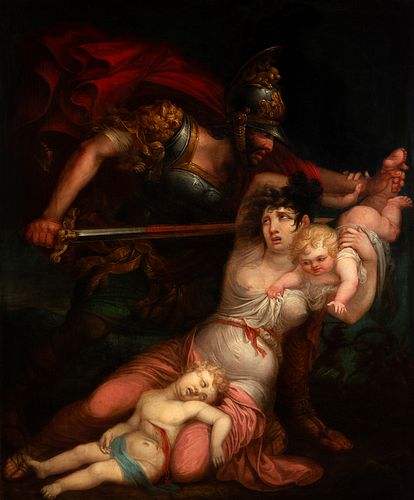SALVADOR MAYOL (Barcelona, 1765 - 1834). "The Slaughter of the Innocents. Oil on canvas. Signed with initials. Size: 144 x 118 cm; 164 x 138 cm (f
Lot 117
About Seller
Setdart Auction House
Carrer Aragó 346
Barcelona
Spain
Setdart Subastas was born in 2004 and is currently the first online art auction in Spain with solidity, prestige and reliability guaranteed by our more than 60,000 users. Setdart has a young, dynamic and enterprising team ready to successfully manage the purchase and sale of art works through custom...Read more
Estimate:
EUR€18,000 - EUR€20,000
$18,947.37 - $21,052.63
Absentee vs Live bid
Two ways to bid:
- Leave a max absentee bid and the platform will bid on your behalf up to your maximum bid during the live auction.
- Bid live during the auction and your bids will be submitted real-time to the auctioneer.
Bid Increments
| Price | Bid Increment |
|---|---|
| EUR€0 | EUR€10 |
| EUR€200 | EUR€25 |
| EUR€500 | EUR€50 |
| EUR€1,000 | EUR€100 |
| EUR€3,000 | EUR€200 |
| EUR€5,000 | EUR€500 |
| EUR€10,000 | EUR€1,000 |
| EUR€20,000 | EUR€2,000 |
| EUR€50,000 | EUR€5,000 |
About Auction
By Setdart Auction House
Oct 20, 2021
Set Reminder
2021-10-20 07:30:00
2021-10-20 07:30:00
America/New_York
Bidsquare
Bidsquare : OLD MASTERS
https://www.bidsquare.com/auctions/setdart-auction-house/old-masters-7700
Setdart Auction House sofia@setdart.com
Setdart Auction House sofia@setdart.com
- Lot Description
SALVADOR MAYOL (Barcelona, 1765 - 1834). "The Slaughter of the Innocents. Oil on canvas. Signed with initials. Size: 144 x 118 cm; 164 x 138 cm (frame). Salvador Mayol stages the biblical story of the Slaughter of the Innocents. We are in front of a canvas of a high pictorial level, which combines the baroque tradition with neoclassical elements typical of the artist, full of dynamism and magnificence, of impeccable execution. The scene is entirely occupied by the contorted figure of a woman desperately defending her sons, one of whom is now dead, against the executioner. The bloody sword, the violent posture of the soldier, and the dead child lying on top of the woman, highlight the explicit violence of one of the cruelest episodes in the history of Bethlehem. The Slaughter of the Innocents is a biblical account incorporated by Matthew into his Gospel (Matthew 2:16-18). According to Matthew and other apocryphal sources, such as the Armenian Gospel of the Infancy, Herod I the Great would have given the order to execute all children born in Bethlehem under the age of two, in an attempt to put an end to the life of Jesus, who, according to the prophecies, was to end his power. The scene was a great success from the last centuries of the Roman Empire (it appears in the mosaics of the 5th-century basilica of Santa Maria Maggiore in Rome), and throughout the Middle Ages and the modern period, giving rise to interpretations full of dynamism, violence and expressiveness, such as, for example, Rubens' version, one of his masterpieces. Salvador Mayol trained at the School of Fine Arts in Barcelona, where he later taught under Joseph Flaugier, a French painter with neoclassical convictions who had settled in Barcelona. He enjoyed considerable prestige as a portraitist in his native city. During the Bourbon occupation he moved to Mallorca, where he continued to devote himself to painting and gathered around him a considerable group of disciples. At the end of the war he returned to Barcelona, where he cultivated genre painting (historical, religious and biblical), portraiture and drawing. In 1820 he offered the Diputació de Barcelona the painting Allegory of the Constitution of 1820, which was highly acclaimed by local critics. He took part in the Llotja Exhibition of 1826, with the works El descenso de la cruz ("Descent from the Cross") and Baile de Boleras ("Boleras Dance"). In 1829 he entered the San Fernando Royal Academy. Throughout his career he worked in various genres, such as mythology, religion, portraiture and genre painting, but he was particularly known and appreciated for the latter two. Many of Mayol's works are kept in the Museum of Lluc (Mallorca), the Museum of Modern Art in Barcelona, the Víctor Balaguer Library-Museum (Vilanova i la Geltrú), the Goya Museum in Castres (France), the Museum of History of the city of Barcelona, the Academy of Fine Arts of Sant Jordi and private collections.
- Shipping Info
-
In-house shipping available. Please inquire at admin@setdart.com.
-
- Buyer's Premium



 EUR
EUR CAD
CAD AUD
AUD GBP
GBP MXN
MXN HKD
HKD CNY
CNY MYR
MYR SEK
SEK SGD
SGD CHF
CHF THB
THB








